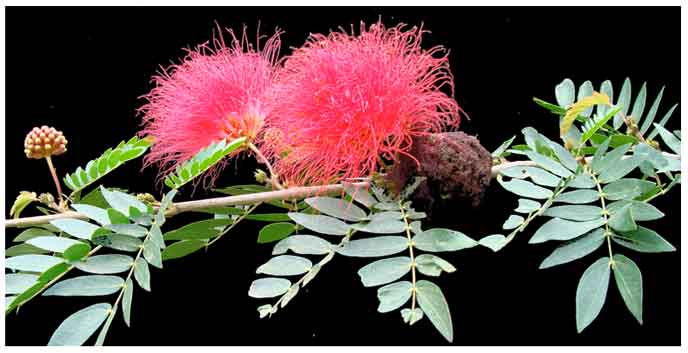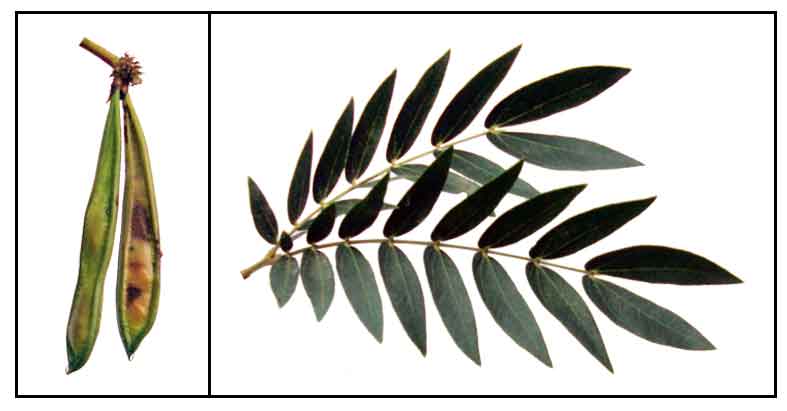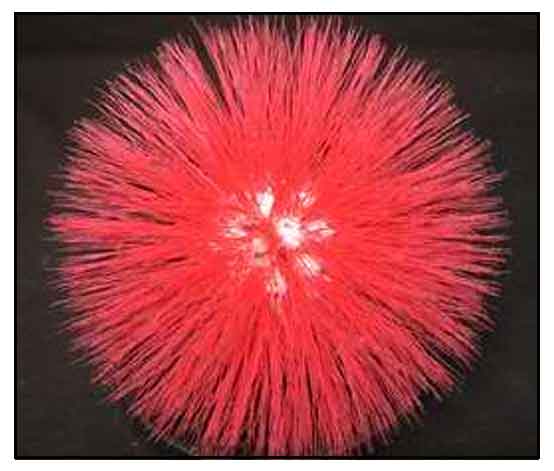Botany
Calliandra haematocephala is a spreading well-branched shrub or small tree, growing to a height of 1 to 3 meters. Branches are brown, cylindric, and rough. Leaves are pinnately compound, oblong, acute, with 5 to 10 pairs of glossy green leaflets. Flowers are clustered in globose heads, up to 7 centimeters across. Stamens are numerous, long and silky, very brilliant, pink to red. Fruit is a dehiscent pod, dull brown, linear -oblanceolate, 6 to 11 centimeters long, 5 to 13 millimeters wide, opening along the sutures when ripe. Seeds are 5 to 6, brown and oblong.

Distribution
- Ornamental cultivation; grown in gardens and parks.
- Native to tropical America.

 Constituents Constituents
- Fractionation of EtOAC extract of bark yielded p-hydroxybenzoic acid, caffeic acid, protocatechuic acid, astilbin, neo-isoastilbin, and catechin-3-O-rhamnoiside. (See study below) (6)
-
A non-active fraction yielded lupeol and betulinic acid.
- Condensed tannins from leaf were prodelphinidins, mainly of (epi)gallocatechin and (epi)gallocatechin-3-O-gallate units. Condensed tannins from wigs and stem bark were predominantly of procyanidins, with catechins, epicatechin, and (epi)catechin-3-O-gallate as main constituents. (see study below) (9)
- Phytochemical screening of flowers yielded alkaloids, tannins, cardiac glycosides, saponins, and flavonoids. (see study below) (12)
- Study of a hexane fraction of leaves isolated lupeol and a mixture of sterols, together with four major fatty acids (palmitic, oleic, linoleic and linolenic). (see study below) (13)
- Phytochemical screening of leaves and stems yielded three new acylated quercetin rhamnosides vuz, quercitrin 2′′-O-caffeate (1), quercitrin 3′′-O-gallate (2) and quercitrin 2′′,3′′-di-O-gallate (3), aong with 17 known compounds gallic acid (4), methyl gallate (5), caffeic acid (6), myricitrin (7), quercitrin (8), myricetin 3-O-β-D-4C1-glucopyranoside (9), afzelin (10), isoquercitrin (11), myricetin 3-O-(6′′-O-galloyl)-β-D-glucopyranoside (12), myricitrin 2′′-O-gallate (13), quercitrin 2′′-O-gallate (14), afzelin 2′′-O-gallate (15), myricitrin 3′′-O-gallate (16), afzelin 3′′-O-gallate (17), 1,2,3,4,6-penta-O-galloyl-β-D-4C1-glucopyranose (18), myricitrin 2′′,3′′-di-O-gallate (19), and quercetin 3-O-methyl ether (20), (see study below) (19)
- Study of ethyl acetate extract isolated three flavonoid aglycones, quercetin, kaempferol, and myricetin, along with three flavonoid glycosides, quercetin-3-O-rthamnopyranoside, keampferol-3-O-(2“-O-galloyl)- rhamnopyranoside and myricetin-3-O-(2“,3“-di-O-galloyl)-rhamnopyranoside. (26)
-
Study for volatile constituents isolated 64 compounds. representing 93.32% of total volatiles of the plant. Oxygenated and non-oxygenated compounds constituted 72.34% and 20.98% respectively. (see study below) (26)
Properties
- Studies with other species of the genus showed various pharmacological properties: anti-inflammatory, anticonvulsant, immunomodulatory, and antiulcerogenic.
Uses
Folkloric
• No reported folkloric medicinal use in the Philippines.
• In Nigeria, roots used in the treatment of hemorrhoids. (7) Leaf and root used for measles. (22)
• Elsewhere, decoction of the flowers used as blood purifier and tonic.
• In China, flower, leaf, and bark used for its tranquilizing effect. (21)
Studies
• Antioxidant / Flavonol Glycosides / Cytotoxicity:
Study isolated three new acylated quercetin rhamnosides from the leaves and stems – quercitrin 2"-O-caffeate, quercitrin 3"-O-gallate and quercitrin  2",3"-di-O-gallate – with 17 known compounds. Six compounds exhibited moderate to strong radical scavenging properties. Compounds 7 and 8 (myricitrin and quercitrin) exhibited lethal effect towards brine shrimp Artemia salina. (1) 2",3"-di-O-gallate – with 17 known compounds. Six compounds exhibited moderate to strong radical scavenging properties. Compounds 7 and 8 (myricitrin and quercitrin) exhibited lethal effect towards brine shrimp Artemia salina. (1)
• Gastroprotective:
Study of butanolic extract for gastroprotective effects in acute gastric lesions induced by acidified alcohol showed a gastroprotective effect with moderate control of gastric lesions and inhibition of hemorrhage and necrotic aspects of tissue injury. The mechanism of activity was probably through a cytoprotective property interfering with the ulcerogenic mechanism. (5)
• Antibacterial / Bark / Leaves:
Study evaluated ethanolic extractable constituents of bark of C. haematocephala against selected bacteria. Results showed varied antibacterial activity. Fractionation yielded known compounds which showed varied antibacterial activity. (see constituents above) (6) Study for antibacterial activity of ethanolic extract of leaves showed moderate activity against gram negative bacterial strains like Salmonella typhi, Serratia marcescens, Shigella flexneri and gram positive strains like Staphylococcus aureus, Bacillus subtilis and Micrococcus luteus. (15)
• Condensed Tannins / Antioxidants:
Condensed tannins isolated from bark, stems, and leaves of Calliandra haematocephala were evaluated for in vitro antioxidant activities using ABTS+ and FRAP methods. All the condensed tannins exhibited stronger antioxidant activities than synthetic antioxidant BHA. Activity was related to the number of hydroxyl groups on the B-ring and level of 3-O-galloylation. (see constituents above) (9)
• Anti-Rotaviral / Leaves:
Study evaluated the antiviral activity of various extracts from Calliandra haematocephala leaves against rotavirus (RS) infection in-vitro. All extracts of CH at non-cytotoxic concentrations exhibited anti-RV activities with the methanol extract showing strongest activity. In vivo oral administration of the ME significantly reduced mortality, virus titers, duration, and severity of diarrhea, as well as alleviation of RV-related small intestinal lesions. (10)
• Silver Nanoparticles / Leaves:
Study reports on the synthesis of silver nanoparticles using Calliandra haematocephala leaf extract. Study showed antibacterial activity against E. coli and the capacity to detect hydrogen peroxide suggesting potential applications in the development of new antibacterial drugs and new biosensors. (11)
• Antimicrobial / Antihelmintic
/ Flowers: Study of extract from flowers of C. haematocephala showed in-vitro antimicrobial activity against gram positive Staphylococcus aureus and anti-helmintic activity against earthworm Eisenia foetida. (see constituents above) (12)
• Antihepatotoxic / Antioxidant: Study evaluated the hepatoprotective and antioxidant activities of total alcohol extract against carbon tetrachloride-induced liver damage in vivo. Results showed significant decrease in the lever of serum enzymes ALT, AST, GGT and bilirubin. There was a decrease in MDA content and increase in levels of SOD, GSH and CAT compared to intoxicated rats. The antioxidant and hepatoprotective effects may be attributed to phenolics, flavonoids, or the saponins content acting as free radical scavengers, inhibiting lipid peroxidation and increasing antioxidant activities. (13)
• Wound Healing / Antioxidant / Leaves: Study evaluated an ethyl acetate extract ointment formulation of powdered leaves of C. haematocephala for wound healing activity in incision and excision in-vivo models. Results showed a wound healing effect with significant )p<0.05) increase in tensile strength and well as hydroxyproline and protein level of healed skin tissues. Effect could be related to its antioxidant property. (14)
• Antisickling Potential / Leaves and Roots: Study evaluated the antisickling activities of two Calliandra species namely C. portoricensis and C. haematocephala on human sickled red blood cells in vitro. The antisickling assays of ethanolic and aqueous extracts of leaves and roots of the two Calliandra species showed both inhibitory and reversal activities. The ethanolic root extract of Calliandra portoricensis exhibited the highest inhibitory (90.19%) and reversal (92.63%) activities at 4 mg/ml. (16)
• Anthelmintic / Flowers: Study evaluated the in vitro anthelmintic activity of various concentrations of flower extract of Calliandra haematocephala.against earthworm, Eisenia foetida. Albendazole was used as standard. Results showed potent (p<0.05) in vitro anthelmintic effect. (17)
• Alpha-Amylase and Alpha-Glucosidase Inhbitiroy Effect / Antidiabetic / Leaves: Study evaluated the alpha-amylase and alpha-glucosidase inhibitory potential of C. haematocephala leaves. Results showed maximum percentage inhibition against alpha-amylase of 61% and alpha glucosidase of 71% with IC50s of 82.18 and 31.07 µg/ml, respectively. Results suggest potential significant role in the pharmacotherapy of diabetes mellitus. (18)
• Radical Scavenging / Cytotoxicity / Leaves and Stems: Study of leaves and stems isolated three new acylate quercetin rhamnosides along with 17 known compounds. Compounds 7, 8, 13, 14, 16, and 19 exhibited moderate to strong radical scavenging properties on lipid peroxidation hydroxyl radical, superoxide anion generation and DPPH radical in comparison with quercetin as control. Compounds 7 and 8 showed lethan effect towards brine shrimp Artemia salina. (see constituents above) (19)
• Formulation of Herbal Effervescent Granules / Leaves: Study reported on the formulation of herbal effervescent granules by incorporating the leaves extract of C. haematocephala. The leaf extract yielded carbohydrates, alkaloids, flavonoid, glycoside and protein. The effervescent granules exhibited excellent flow properties which showed good angle of repose, Carr's index, Hausner's ration, bulk density and tapped density. (20)
• Gastroprotective / Immunomodulatory : Study evaluated a butanolic extract of C. haematocephala for gastroprotective and immunoadjuvant properties. Acute gastric lesions were induced by acidified ethanol and cimetidine was used as reference drug. Immunoadjuvant activity was evaluated against ovalbumin antigen. Both experiments corroborated the biological properties, which justifies use of the plant as stomach protector and immunomodulator. (23)
• Antibacterial Effects on Acne Vulgaris: Study evaluated methanolic extracts of Callistemon lanceolatus and Calliandra haematocephala against the main causative agents of acne: Staphylococcus aureus and S. epidermidis. Results showed both plant extracts showed comparable results with antibiotics like Clindamycin and chemicals like Benzoyl Peroxide. (24)
• C. haematoephala Mediated Zinc Oxide Nanoflowers: Study reports on the synthesis, characterization and photocatalytic dye degradation capability of C. haematocephala-mediated zinc oxide nanoflowers. (25)
• Flavonoids / Volatiles / Biologic Activities / Aerial Parts: Study evaluated dried powdered aerial parts for flavonoids, volatiles, and biologic activities. Ethyl acetate extract isolated three flavonoid aglycones, quercetin, kaempferol, and myricetin, along with three flavonoid glycosides, quercetin-3-O-rthamnopyranoside, keampferol-3-O-(2“-O-galloyl)- rhamnopyranoside and myricetin-3-O-(2“,3“-di-O-galloyl)-rhamnopyranoside. Study for volatile constituents isolated 64 compounds. The LD50, analgesic, antipyretic, anticonvulsant, anti-ulcer activity of successive extracts and antioxidant activity were investigated. Most of the isolated extracts were found to be significantly active. (see constituents above) (26)
Availability
Wild-crafted. |

![]()

